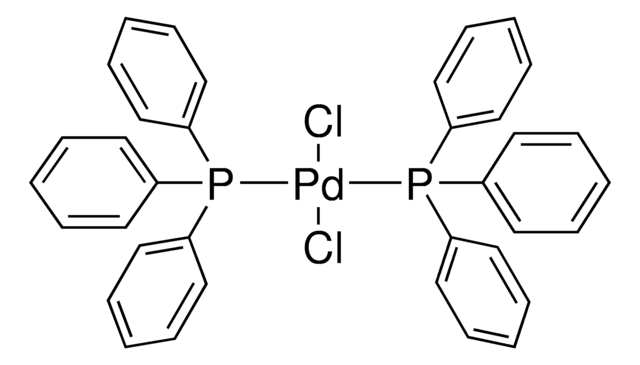215554
Copper(I) iodide
99.999% trace metals basis
Sinónimos:
Cuprous iodide
About This Item
Productos recomendados
presión de vapor
10 mmHg ( 656 °C)
Nivel de calidad
Ensayo
99.999% trace metals basis
Formulario
powder and chunks
impurezas
≤15.0 ppm Trace Metal Analysis
bp
1290 °C/1 atm (decomp)(lit.)
mp
605 °C (lit.)
solubilidad
dilute aqueous acid: insoluble(lit.)
densidad
5.62 g/mL at 25 °C (lit.)
aplicaciones
battery manufacturing
cadena SMILES
[Cu+].[I-]
InChI
1S/Cu.HI/h;1H/q+1;/p-1
Clave InChI
LSXDOTMGLUJQCM-UHFFFAOYSA-M
¿Está buscando productos similares? Visita Guía de comparación de productos
Aplicación
- For arylation of pyrazole and derivatives by coupling arenediazonium species under mild and ligand-free conditions.
- Selective cross-coupling of dibromo alkenes and heteronucleophiles which leads to numerous building blocks such as 1-bromoenamides, ynamides, ketene N, N-acetals, 1-bromoenol ethers, ynol ethers, ketene O, O-acetals, and vinyl phosphonates.
- Stereospecific and the regioselective reaction of silacyclopropanes with carbonyl compounds.
Características y beneficios
- Low toxicity
- Mild reaction condition
- High purity ensures reproducibility and avoids cocatalysis by contaminants.
Palabra de señalización
Danger
Frases de peligro
Consejos de prudencia
Clasificaciones de peligro
Acute Tox. 4 Oral - Aquatic Acute 1 - Aquatic Chronic 1 - Eye Dam. 1 - Skin Irrit. 2 - Skin Sens. 1A - STOT RE 1 Oral
Órganos de actuación
Thyroid
Código de clase de almacenamiento
6.1C - Combustible acute toxic Cat.3 / toxic compounds or compounds which causing chronic effects
Clase de riesgo para el agua (WGK)
WGK 3
Punto de inflamabilidad (°F)
Not applicable
Punto de inflamabilidad (°C)
Not applicable
Equipo de protección personal
dust mask type N95 (US), Eyeshields, Gloves
Elija entre una de las versiones más recientes:
Certificados de análisis (COA)
¿No ve la versión correcta?
Si necesita una versión concreta, puede buscar un certificado específico por el número de lote.
¿Ya tiene este producto?
Encuentre la documentación para los productos que ha comprado recientemente en la Biblioteca de documentos.
Los clientes también vieron
Artículos
We carry a large variety of electrophiles and nucleophiles that are widely used in C–C bond-forming reactions. This group of products contains many organometallic reagents as well as commonly-used alkylating and acylating reagents.
Nuestro equipo de científicos tiene experiencia en todas las áreas de investigación: Ciencias de la vida, Ciencia de los materiales, Síntesis química, Cromatografía, Analítica y muchas otras.
Póngase en contacto con el Servicio técnico
















